
This page last revised 23 August 2006 -- S.M.Gon III
Introduction
Ecoregion
Conservation Targets
Viability
Goals
Portfolio
TNC Action Sites
Threats
Strategies
Acknowledgements
▫
Tables
Maps & Figures
CPT Database
Appendices
Glossary
Sources
.
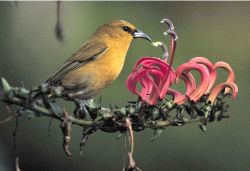
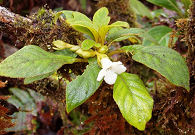
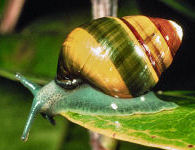
Among the many invertebrates of the lowland wet system are endangered tree snails.
Lowland Wet System
Natural communities below1,000 m (ca 3,000 ft) elevation, receiving greater than 75inches annual precipitation, or otherwise bearing prevailingly wetsubstrate conditions comprise the lowland wet system in theHawaiian High Islands Ecoregion. This system is found on theislands of Hawai‘i, Maui, Moloka‘i, Lāna‘i,O‘ahu, and Kaua‘i, and is best developed on the windwardside of the highest islands (Maui and Hawai‘i) and the windwardto summitregions of the lower islands, for example, the lower east flank ofMauna Kea, the northeast flank of Haleakalā (Maui), the heads of thenorthern valley systems of EastMoloka‘i, the near-summit slopes of Lāna‘ihale(Lāna‘i), theslopes surrounding summit of Ka‘ala (Wai‘anae Mountains,O‘ahu), the majority of the Ko‘olau Mountains(O‘ahu), and the weet valleys and slopes adjacent to thesummit plateau of Wai‘ale‘ale and Alaka‘i,Kaua‘i. It typically lies below the montane wet system and wet cliff system. There are a number of naturalcommunities described within this system, including a variety of wet grasslands, shrublands, and forests. Biologicaldiversity is high in this system, and specialized plants and animals occur there, such as tree snails (e.g., Achatinella and Partulina spp.) and endemic Cyrtandra spp.
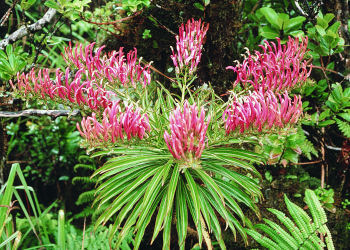
The koli'i, an endemic lobeliad (Trematolobelia macrostachys), is a showy occupant of the lowland wet system, whose blossoms are pollinated by coadapted native forest birds.
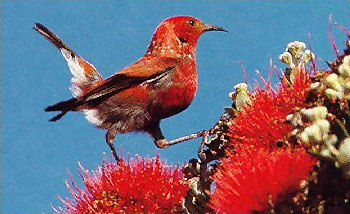
Onceexcluded from the lowland wet forests by mosquito-borne diseases, themost common native honeycreepers, such as the 'apapane (Himationesanguinea) are recolonizing the lowlands.
Natural communities and species of this system are listed among nested targets via the appendices.

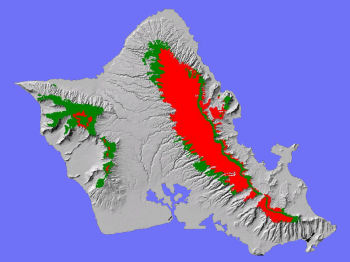
TheLowland Wet System on O'ahu (red areas above) is most prominent inthe Ko'olau conservation area (right), but also occurs on slopessurrounding the montane wet summit of the Wai'anae conservation area(left), and on a few small peaks just below1,000 m. (3,000 ft.) elevation.
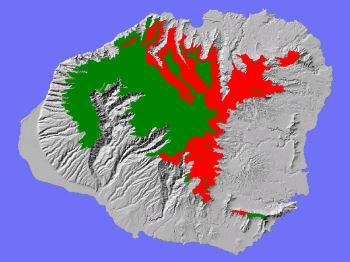
TheLowland Wet System on Kaua'i (red areas above) dominates thewindward (eastern) half of the island below1,000 m. (3,000 ft.) elevation.


Natural communities and species of this system are listed among nested targets via the appendices.



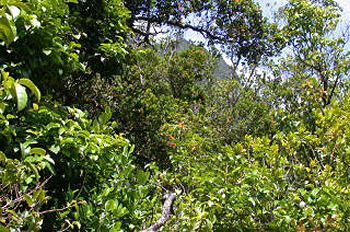
TheLowland Wet System in Hawai‘i includes wet forests of remarkablebotanical diversity, such as this example in Lumaha'i Valley, Kaua'i.


Distribution of the Lowland Wet System across the Hawaiian High Islands Ecoregion is depicted in the series of figures below:
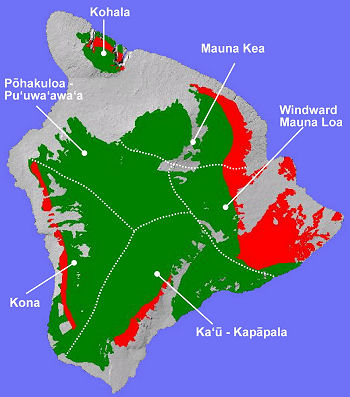
The Lowland Wet System on Hawai‘i Island(red areas above) occurs in five conservation areas (Kohala, Mauna Kea, Windward Mauna Loa, Ka‘ū-Kapāpala, and Kona) at <3,000 ft elev.
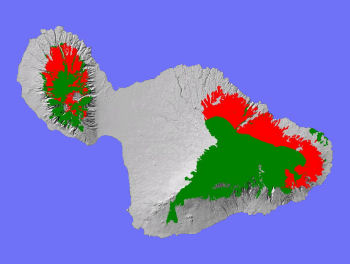
TheLowland Wet System on Maui (red areas above) occursalong the windward flanks of both the East Maui and West Mauiconservation areas below 1,000 m. (3,000 ft.) elevation.
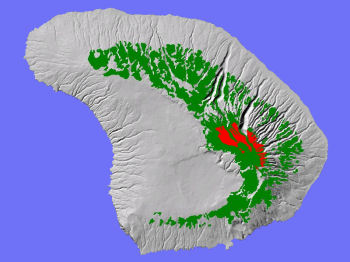
TheLowland Wet System on Lāna'i (red areas above) occurs immediately adjacent to the montane wet summit of theconservation area, below 1,000 m. (3,000 ft.) elevation.
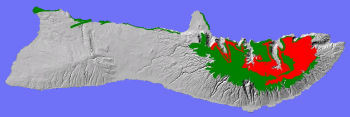
TheLowland Wet System on Moloka'i (red areas above) is prominent onthe eastern half of the island's conservation area, but is beingsteadily degraded by uncontrolled feral ungulates such as pigs and deerbelow 1,000 m. (3,000 ft.) elevation.

